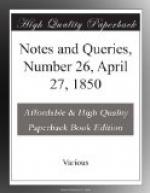“The English and French
Prophets mad, or bewitcht, at their
assemblies in Baldwin’s
Gardens.”
A Letter of Anthony Wood’s, in the writer’s collection, is thus addressed:—
“For John Aubrey, Esq.
To be left at Mr. Caley’s house, in
Baldwin’s Gardens,
neare Gray’s Inne Lane, London.”
The White Hart, Bishopsgate Street.—A tavern said to be of very ancient date. In front of the present building, the writer of the present notice observed (in 1838) the date cut in stone, 1480.
The Nag’s Head, Cheapside.—A view of this tavern is preserved in a print of the entry of Mary de Medici, when she paid a visit to her son-in-law and daughter, the unfortunate Charles I. and his queen.
St. Paul’s Alley.—
“Whereas, the yearly meeting of the name of Adam hath of late, through the deficiency of the last stewards, been neglected, these are to give notice to all gentlemen, and others that are of that name, that, at William Adams’, commonly called ’The Northern Alehouse,’ in St. Paul’s Alley, in St. Paul’s Church Yard, there will be a weekly meeting, every Monday night, of our namesakes, between the hours of 6 and 8 of the clock in the evening, in order to choose stewards to revive our antient and annual feast.”—Domestic Intelligence, 1681.
St. Paul’s Churchyard.—
“In St. Paul’s Church Yard were formerly many shops where music and musical instruments were sold, for which, at this time, no better reason can be given than that the service at that Cathedral drew together, twice a day, all the lovers of music in London; not to mention that the chairmen were wont to assemble there, where they were met by their friends and acquaintance.”— Sir John Hawkins’ History of Music, vol. v. p. 108.
The French Change, Soho.—A place so called in the reign of Queen Anne. Gough, in a MS. note, now before us, thought it stood on the site of the present bazaar.
EDWARD F. RIMBAULT.
* * * * *
NOTES ON THE DODO.
I have to thank “Mr. S.W. SINGER” (No. 22. p. 353.) for giving some interesting replies to my “Dodo Queries” (No. 17. p. 261.). I trust that Mr. S. will be induced to pursue the inquiry further, and especially to seek for some Portuguese account of the Mascarene Islands, prior to the Dutch expedition of 1598. I am now able to state that the supposed proof of the discovery of Bourbon by the Portuguese in 1545, on the authority of a stone pillar, the figure of which Leguat has copied {411} from Du Qesne, who copied it from Flacourt, turns out to be inaccurate. On referring to Flacourt’s Histoire de la Grande Isle Madagascar, 4to., Paris, 1658, p. 344, where the original figure of this monument is given, I find that the stone was not found in Bourbon at all, but in “l’Islet des




